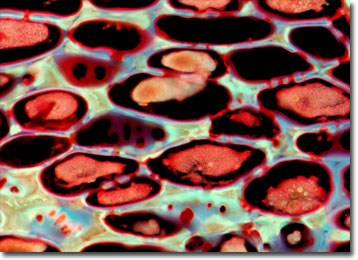Fluorescence Digital Image Gallery
Lily Seeds
The lily family Liliaceae contains more than 4,000 species, but the term lily is usually applied to only about 100 species of plants that belong to the genus Lilium. Due to their characteristic showy blossoms, lilies are among the oldest cultivated plants, having been utilized as garden ornamentals since the early days of ancient Greece and Rome.

Lilies are herbaceous flowering plants that thrive in warm temperate and tropical climates. As monocots, the bisexual lily buds typically exhibit three sepals, three petals, and six stamens, each bearing a bilobed anther containing four pollen sacs. Additionally, the buds feature a single central pistil leading to an ovary, usually with six ovules, which is enclosed by three fused carpals. Although sexual reproduction by seed is possible, lilies are usually commercially grown via asexual bulbs to ensure that the plants maintain enough energy for flowering.
Richly symbolic, lilies have a long history of special significance to humans. Minoans believed the plants were sacred and associated them with their goddess Britomartis. In fact, Minoan artifacts exhibiting representations of lilies have been discovered that date back to around 1580 BC. Ancient vases and relics etched with lilies have also been found in Egypt, where the plants were often revered as symbols of light. In ancient Greece and Rome, however, lilies were emblematic of innocence and were woven into crowns worn by brides during their weddings, a tradition carried over into modern times by brides carrying lily-filled bouquets. The significance of lilies has prevailed in other ways, as well, especially in association with the Christian religion, as demonstrated by the popularity of the Easter lily.
BACK TO THE FLUORESCENCE DIGITAL IMAGE GALLERY
